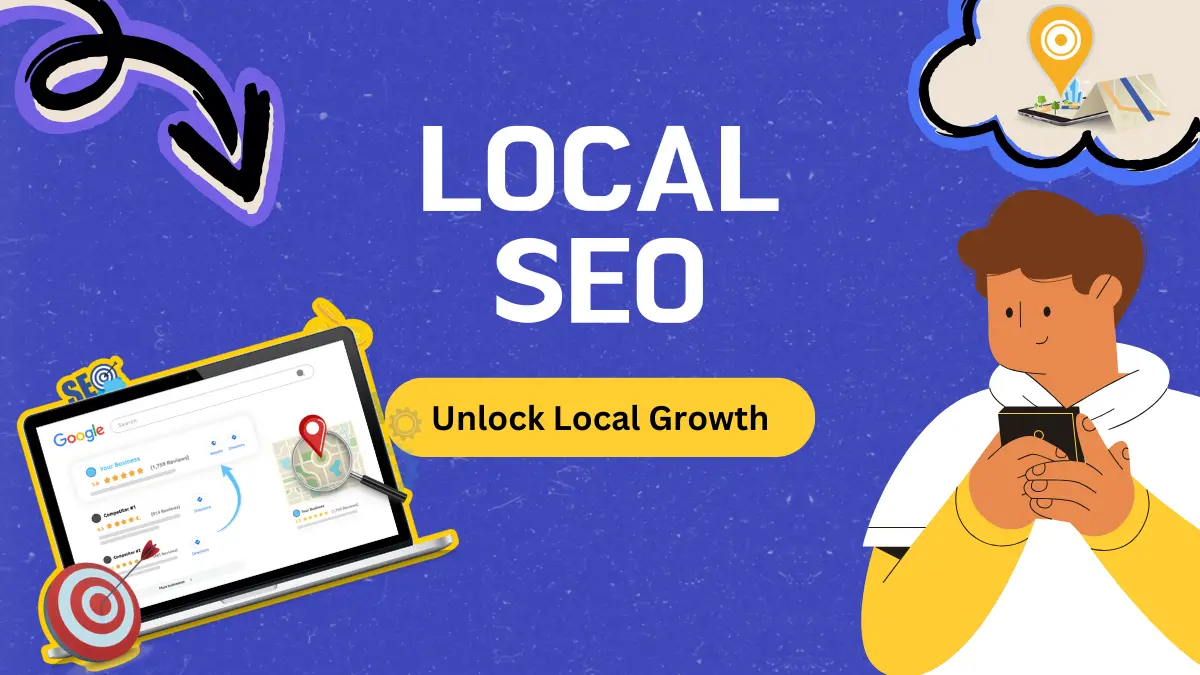Unlock Local Growth: Your Guide to Local SEO for Every Inch of Your Business
In today’s digital world, your potential customers are searching for products and services online. While national brands compete globally, the real magic for local businesses often happens right around the corner. That’s where Local Search Engine Optimization (SEO) comes in – it’s about making sure your business shows up when people nearby are looking for what you offer.
Think about it: when someone needs a “plumber near me,” a “bakery in [Your Town Name],” or “best coffee shop downtown,” they aren’t just browsing; they have a specific need and are ready to act. Local SEO is your strategy to be found at that exact moment.
Why is local SEO for each and everything so vital? Because it touches every part of your online presence that connects with a physical location and local customers. It’s not just one trick; it’s a comprehensive approach that makes your business visible, trustworthy, and easily accessible to your neighbors.
Why Local SEO Matters More Than Ever
- Captures Ready-to-Buy Customers: People searching locally are often at the bottom of the funnel – they’re looking to visit or purchase now.
- Beats Out Competition: Many local businesses neglect their online presence. Strong local SEO gives you a massive advantage.
- Builds Trust & Credibility: Appearing in local search results, especially the “Local Pack” (the map results), makes your business look established and reliable.
- Drives Foot Traffic & Phone Calls: Local searches directly lead to customers walking through your door or calling for services.
- Cost-Effective: Compared to traditional advertising, local SEO offers an excellent return on investment.
Local SEO for Each and Everything: Where It Applies
Local SEO isn’t confined to just one place. It’s a strategy that needs to be woven into various aspects of your online footprint:
- Your Website:
- Location Pages: Dedicated pages for each physical location (if you have multiple).
- Localized Content: Blog posts, service descriptions, and testimonials that mention your town, neighborhood, or local landmarks.
- On-Page Optimization: Using local keywords (e.g., “pizza place [Town Name]”) in titles, headers, and content.
- Mobile-Friendliness: Crucial for users on the go searching on their phones.
- Online Directories & Listings (Citations):
- Ensuring your business information (Name, Address, Phone Number – NAP) is consistent across countless online platforms like Yelp, Yellow Pages, industry-specific directories, etc.
- These act like digital mentions that help search engines verify your business’s location and legitimacy.
- Google Business Profile (GBP):
- Formerly Google My Business, this is arguably the most critical local SEO tool. It controls your listing on Google Maps and in the local search results.
- Optimizing your profile with accurate info, photos, services, hours, and posts is paramount.
- Online Reviews & Reputation:
- Encouraging customers to leave reviews (especially on Google and Yelp).
- Responding thoughtfully to all reviews, positive and negative. This shows engagement and builds trust.
- Local Link Building:
- Getting links from other local businesses, community organizations, news sites, or blogs. This signals local relevance and authority to search engines.
- Social Media:
- Engaging with your local community online. Sharing local news, participating in local groups, running location-targeted ads.
Key Steps to Grow Your Business Locally with SEO
Implementing a strong local SEO strategy might seem daunting, but by breaking it down into actionable steps, you can build a powerful local online presence.
Step 1: Claim and Optimize Your Google Business Profile (GBP)
- Action: Go to google.com/business and claim or create your listing.
- Why It’s Crucial: This is often the first thing potential customers see.
- Optimization:
- Fill out every section completely and accurately.
- Choose the most relevant categories for your business.
- Add high-quality photos and videos of your business, products, and services.
- Include your exact address, phone number, and website.
- Set accurate business hours, including special hours for holidays.
- Enable messaging and Q&A features.
- Regularly post updates, offers, or news using the “Posts” feature.
Step 2: Build and Maintain Consistent NAP Citations
- Action: List your business on major online directories and platforms.
- Why It’s Crucial: Search engines cross-reference your information. Inconsistent NAP (different phone numbers, spelling of street names, etc.) confuses them and hurts your ranking.
- How: Start with major ones like Yelp, Bing Places, Facebook, Apple Maps, and industry-specific directories (e.g., Healthgrades for doctors, Zillow for real estate). Ensure your Name, Address, and Phone Number are identical across all listings.
Step 3: Optimize Your Website for Local Search
- Action: Integrate local keywords and information into your website.
- How:
- Include your full business name, address, and phone number prominently on your website (footer is common).
- Embed a Google Map of your location on your contact page.
- Create location-specific pages if serving multiple areas or having multiple branches.
- Use local keywords naturally in your page titles, meta descriptions, headers (H1, H2), and content.
- Add location schema markup to your website code (this is more technical but tells search engines your location data).
Step 4: Gather and Manage Online Reviews
- Action: Actively encourage satisfied customers to leave reviews and respond to them.
- Why It’s Crucial: Reviews build trust with potential customers and are a significant local ranking factor.
- How:
- Politely ask happy customers to leave a review on Google (provide an easy link!), Yelp, or other relevant platforms.
- Respond to all reviews, positive or negative. Thank positive reviewers. Address negative ones professionally and offer solutions or clarification.
Step 5: Create Localized Content
- Action: Write blog posts, articles, or guides relevant to your local area.
- How:
- Write about local events you’re participating in.
- Share news relevant to your community.
- Create guides about local landmarks, activities, or history that relate to your business or industry.
- Highlight local employees or customers (with permission).
Step 6: Build Local Backlinks
- Action: Get other reputable local websites to link to yours.
- Why It’s Crucial: Links from relevant local sources boost your local authority.
- How:
- Join local business organizations (Chamber of Commerce).
- Sponsor local events or sports teams.
- Partner with complementary local businesses for cross-promotion.
- Reach out to local bloggers or news sites.
Step 7: Focus on Mobile-Friendliness and Website Speed
- Action: Ensure your website looks and functions perfectly on smartphones and loads quickly.
- Why It’s Crucial: Most local searches happen on mobile devices. Slow or clunky sites frustrate users and hurt rankings.
- How: Use a responsive website design. Test your site speed using tools like Google PageSpeed Insights.
Step 8: Utilize Local Social Media
- Action: Engage with your local community on platforms like Facebook, Instagram, or Nextdoor.
- How: Share location-specific content, run targeted local ads, join local community groups (following their rules), and interact with local followers.
Step 9: Track and Analyze Your Results
- Action: Monitor your local search performance.
- Why It’s Crucial: See what’s working and what needs improvement.
- How: Use Google Analytics to see website traffic sources (including local search), track calls from your GBP, and use local SEO tools to monitor your rankings for local keywords.
Essential Platforms and Tools for Local Growth
Here are key platforms and types of tools that will be your allies in your local SEO efforts:
- Google Business Profile: (Free) – The absolute cornerstone. Manage your presence on Google Search and Maps.
- Yelp: (Free listing, paid ads) – A major review platform, especially for restaurants, retail, and services.
- Bing Places for Business: (Free) – Optimize your listing for searches on Microsoft Bing.
- Facebook Business Page: (Free listing, paid ads) – Essential for engaging with your local community and running targeted ads.
- Apple Maps: (Free) – Important for iPhone users. Ensure your listing is accurate via Apple Business Connect.
- Other Major Directories: Yellow Pages, Foursquare, local chambers of commerce websites, industry-specific directories (e.g., TripAdvisor for travel/hospitality, Zocdoc for healthcare, Angie’s List/HomeAdvisor for home services).
- Website Platforms: WordPress, Shopify, Wix, Squarespace, etc. – Choose a platform that allows easy SEO customization (titles, descriptions, adding location info).
- Local SEO Software/Tools: (Often Paid, some free trials) – These tools can help automate citation building, track local rankings, monitor reviews, and analyze competitor local strategies. Examples include BrightLocal, Moz Local, SEMrush Local, Whitespark.
- Google Analytics: (Free) – Track website traffic, user behavior, and conversions.
- Google Search Console: (Free) – Monitor your site’s performance in Google Search, submit sitemaps, and fix errors.
Putting It All Together
Local SEO isn’t a magic bullet that works overnight. It’s an ongoing process that requires consistent effort. By systematically working through the steps, optimizing your presence on the key platforms, and focusing on providing excellent local service that generates positive reviews, you build a powerful online foundation.
This comprehensive approach to local SEO – addressing every aspect of your business’s digital footprint that connects with your local community – is the key to unlocking sustainable growth, bringing more customers through your door, and becoming the go-to business in your neighborhood. Start with Google Business Profile and build outwards. Your local customers are searching; make sure they find you.



